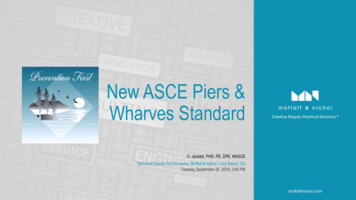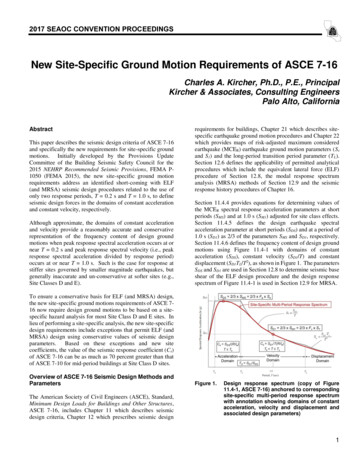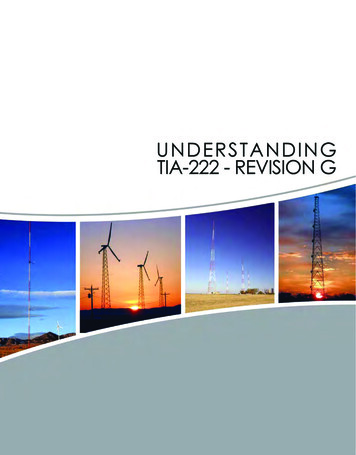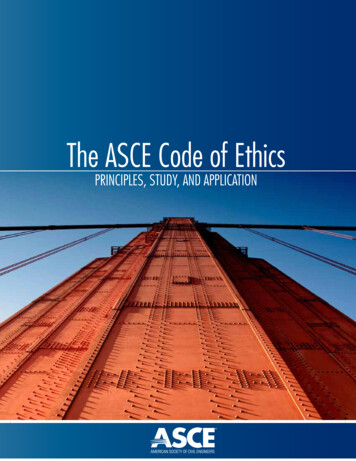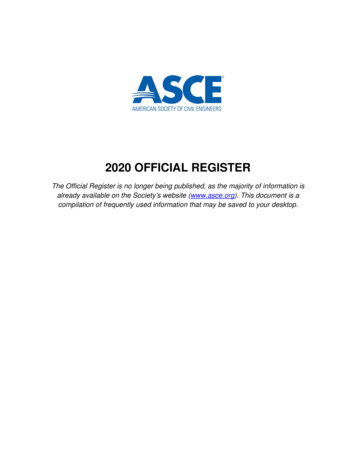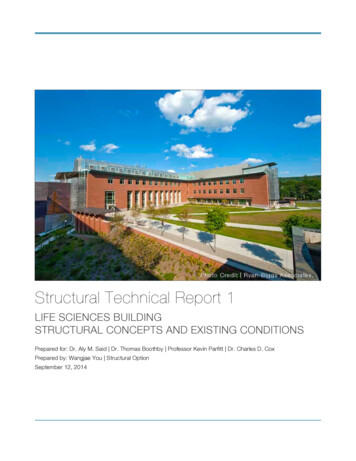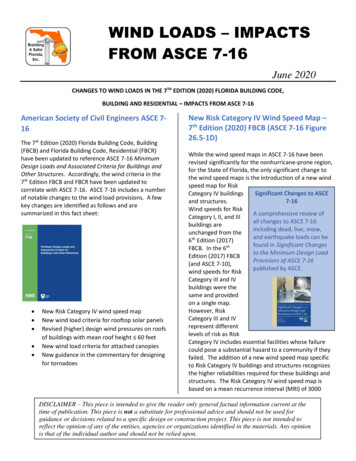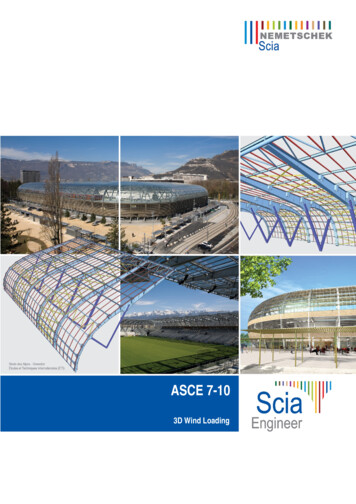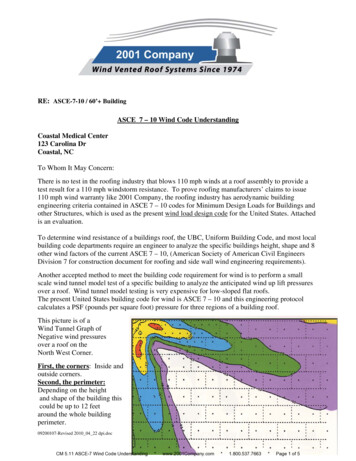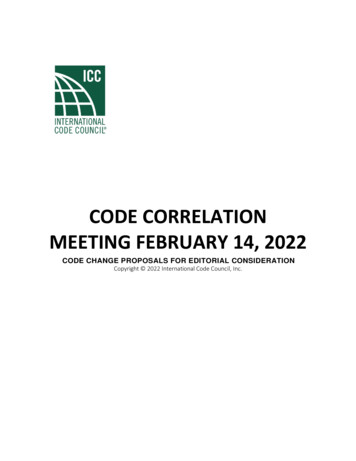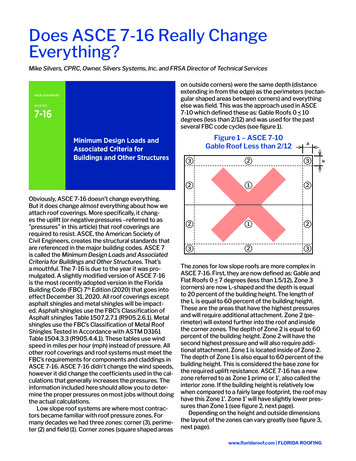
Transcription
Does ASCE 7-16 Really ChangeEverything?Mike Silvers, CPRC, Owner, Silvers Systems, Inc. and FRSA Director of Technical Serviceson outside corners) were the same depth (distanceextending in from the edge) as the perimeters (rectangular shaped areas between corners) and everythingelse was field. This was the approach used in ASCE7-10 which defined these as: Gable Roofs 0 10degrees (less than 2/12) and was used for the pastseveral FBC code cycles (see figure 1).a323212212323aObviously, ASCE 7-16 doesn’t change everything.But it does change almost everything about how weattach roof coverings. More specifically, it changes the uplift (or negative pressures –referred to as"pressures" in this article) that roof coverings arerequired to resist. ASCE, the American Society ofCivil Engineers, creates the structural standards thatare referenced in the major building codes. ASCE 7is called the Minimum Design Loads and AssociatedCriteria for Buildings and Other Structures. That’sa mouthful. The 7-16 is due to the year it was promulgated. A slightly modified version of ASCE 7-16is the most recently adopted version in the FloridaBuilding Code (FBC) 7th Edition (2020) that goes intoeffect December 31, 2020. All roof coverings exceptasphalt shingles and metal shingles will be impacted. Asphalt shingles use the FBC’s Classification ofAsphalt shingles Table 1507.2.7.1 (R905.2.6.1). Metalshingles use the FBC’s Classification of Metal RoofShingles Tested in Accordance with ASTM D3161Table 1504.3.3 (R905.4.4.1). These tables use windspeed in miles per hour (mph) instead of pressure. Allother roof coverings and roof systems must meet theFBC’s requirements for components and claddings inASCE 7-16. ASCE 7-16 didn’t change the wind speeds,however it did change the coefficients used in the calculations that generally increases the pressures. Theinformation included here should allow you to determine the proper pressures on most jobs without doingthe actual calculations.Low slope roof systems are where most contractors became familiar with roof pressure zones. Formany decades we had three zones: corner (3), perimeter (2) and field (1). Corner zones (square shaped areasFigure 1 – ASCE 7-10Gable Roof Less than 2/12The zones for low slope roofs are more complex inASCE 7-16. First, they are now defined as: Gable andFlat Roofs 0 7 degrees (less than 1.5/12), Zone 3(corners) are now L-shaped and the depth is equalto 20 percent of the building height. The length ofthe L is equal to 60 percent of the building height.These are the areas that have the highest pressuresand will require additional attachment. Zone 2 (perimeter) will extend further into the roof and insidethe corner zones. The depth of Zone 2 is equal to 60percent of the building height. Zone 2 will have thesecond highest pressure and will also require additional attachment. Zone 1 is located inside of Zone 2.The depth of Zone 1 is also equal to 60 percent of thebuilding height. This is considered the base zone forthe required uplift resistance. ASCE 7-16 has a newzone referred to as Zone 1 prime or 1’, also called theinterior zone. If the building height is relatively lowwhen compared to a fairly large footprint, the roof mayhave this Zone 1’. Zone 1’ will have slightly lower pressures than Zone 1 (see figure 2, next page).Depending on the height and outside dimensionsthe layout of the zones can vary greatly (see figure 3,next page).www.floridaroof.com FLORIDA ROOFING1
Figure 2 – ASCE 7-16Gable and Flat Roofs 1.5/12Mean Roof Height0.6h230.6h10.2hΘ0.6h0.6hh3MRHB21Width211'B Horizontal dimension of the building in feet.h Mean Roof Height (MRH) in feet (eave heightplus ridge height divided by 2).13Θ Angle of roof plane from horizontal(slope or pitch).32Figure 3 – ASCE 7-1623123311'1322123Buildings with leasthorizontal dimension greaterthan 2.4h.33212FLORIDA ROOFING December 202033223Buildings with leasthorizontal dimension greaterthan 1.2h but less than 2.4h.Under ASCE 7-10, gable shaped roofs with slopesgreater that 1.5/12 (7 degrees) to 12/12 (45 degrees)used the same three zones as low slope roofs described above (see figure 4, page 20).Under ASCE 7-10, hip-shaped roofs with slopegreater that 1.5/12 (7 degrees) to 6/12 (27 degrees),also used the same three zones as low slope roofsdescribed above (see figure 5, page 20).With ASCE 7-16, it is considerably more complex.For roofs with slopes from 1.5/12 (7 degrees) to 12/12(45 degrees), there are also new zones. For gableroofs, there are now six zones: 3r, 3e, 2e, 2r, 2n and 1.Zone 3r (r ridge) typically sees the highest pressures.These are significantly higher than under ASCE 7-10233323Buildings with least horizontaldimension less than 1.2h andlargest horizontal dimensiongreater than 1.2h.33Buildings with largesthorizontal dimension lessthan 1.2h.for the same roof areas. Zones 3e (e eave), 2e, 2rand 2n (n neutral) see intermediate pressures. Theseverity can interchange between zones dependingon mean roof height, roof slope and building dimensions. Zone 1 sees the least amount of pressure (seefigure 8, page 22).For hip roofs under ASCE 7-16 there are now fourzones: 3, 2e, 2r and 1. Again, Zone 3 sees the highestpressures. Zones 2e and 2r see intermediate pressures. Zone 1 sees the least (see figure 7, page 20).You can see that an understanding of how thesezones are defined and configured is critical for installing roof systems that meet the building coderequirements. Hopefully, the above information and
diagrams have helped with this.The next step is to determine the pressures thatneed to be resisted in these zones and how to get thatinformation. With new construction, this informationshould be shown on the plans. This should include thesize and locations of the zones. Make sure you arelooking at the values for components and cladding.These should be for Vasd –Allowable Stress Design(ASD) which is 60 percent of the Vult – Ultimate StressDesign (ULT). This is due to the Design Wind SpeedConversion in the standard. More on ASD and ULTlater.Figure 4 – ASCE 7-10Gable Roofs 1.5/12 to less than r2r3r2n12n3e2e3eWhat about reroofing? If you are the prime contractor on the alteration (a reroof is a Level 1 alteration)then you must have a way to establish this information. Roofing contractors are very fortunate to havesome great free resources available to help figure thisout. Before we can get the results, we need to havegeneral information about the specific job.These include:a2e3aaaa2e Roof shape (flat, gable or hip)2Figure 7 – ASCE 7-16Hip Roofs 1.5/12 to less than 12/123e Job address including the countya1aFigure 6 – ASCE 7-16Gable and Flat Roofs1.5/12 to less than 12/12a33aaaaaaaaFigure 5 – ASCE 7-10Hip Roofs 1.5/12 to less than 6/1212e2r12r12e12e33 Roof slope or pitch (rise in run or degrees) Mean roof height (eave height ridge height / 2) Building width and length (not includingoverhangs) Risk Category (I, II, III or IV) Exposure Category (B, C or D) Roof system type Applicable design wind speed for the sitewww.floridaroof.com FLORIDA ROOFING3
Let’s start with risk categories I, II, III or IV. The riskcategories are based on use or type of occupancy ofthe building.Figure 8 – FBC Chapter 16 Risk Category I – low risk: temporary, storage oragricultural facilities, etc. Risk Category II – typical buildings: homes,apartments, stores, offices, manufacturing andwarehouses, etc. Risk Category III – substantial hazard: mostschools, high occupancy buildings, nursing homesand other important buildings that are not riskcategory IV. Risk Category IV – essential facilities: medicalfacilities with surgery or emergency services, fireand police stations, emergency shelters and emergency operation centers, etc.Understanding which risk category applies to yourbuilding will allow you to find the proper design windspeed map or enter that information in the programswe will discuss later. Once you have the proper map,you can find the site location and follow the contourlines to find the design wind speed (see figure 8). Youcan interpolate between the wind speed but keep inmind that some counties use the higher wind speedfor the entire county. This is sometimes true even forcounties that are split by wind speeds contours.Hazards by LocationATC Hazards by Location (https://hazards.atcouncil.org)is a great free tool that will allow you to enter an address and then it will produce a windspeed and windmap for that location. The wind speed is shown basedon the risk category I, II, III or IV. Remember, it will usually be category II. Themap makes it easy to seethe next higher windspeed contour line. Youcan use this windspeedto be conservative (safe).It also states whether or not you are in a wind-bornedebris region. Note the wind speed and risk categoryfor the next step. Save the report for your job file.We now have our appropriate windspeed, but before we can move on to the next website that will giveyou a final report, you will need another piece of information. What exposure category is the building in?The exposure categories are B, C and D. They arebased on surface roughness, which are also categoriesB, C and D. Surface Roughness B – urban and suburbanareas, wooded areas or other terrain with numerous closely spaced obstructions having the size ofsingle-family dwellings or larger. Surface Roughness C – open terrain with scattered obstructions having heights generally lessthan 30 feet. This category includes flat opencountry and grasslands. Surface Roughness D – flat unobstructed areas and water surfaces. This category includessmooth mud flats, salt flats and unbroken ice. Exposure B – shall apply where surface roughnessB prevails in the windward direction for a distanceof at least 2,600 feet or twenty times the height.For buildings whose mean roof height is less thanor equal to 30 feet, the upwind distance may bereduced to 1,500 feet. Exposure C – shall apply for all cases whereExposure B or D does not apply. Exposure D – shall apply where surface roughnessD prevails in the upwind direction for a distanceof greater than 5,000 feet. Exposure D shall alsoapply where the ground surface roughness immediately upward of the site is B or C and the site iswithin a distance of 600 feet or 20 times the building height, whichever is greater, from an ExposureD condition.4FLORIDA ROOFING December 2020
Generally, most typical sites will be Exposure B.Areas that adjoin ponds and lakes, golf courses etc.may be Exposure C. Others that are on open water,such as oceans, gulfs, bays and larger lakes – or perhaps a highway or runway – will probably be ExposureD. If in doubt, use the next higher exposure categoryto be conservative. Make a note of the exposurecategory you’ve decided on.If you are installing a tile roof covering, refer to the6th Edition of FRSA-TRI Florida High Wind Concreteand Clay Tile Installation Manual or the High VelocityHurricane Zone (HVHZ) Roofing Application Standard(RAS) 118, 119 or 120.For other than tile and the shingle roofs mentioned earlier, the final step is finding the size ofthe roof zones and their pressures. Again, wehave a great free tool to help us: NRCA provideswww.roofwinddesigner.com. With the information wenow have, we can go on the site and set up an account(a very simple process). Once that’s done, enter a roofarea name (main roof, etc.), job name, address, city,county and zip code.Then enter the building length, width, mean roofheight, roof configuration and slope and parapet wallsif applicable.Next enter the building configuration: enclosed oropen (note: partially enclosed buildings will requireadditional engineering calculations). Most typicalbuildings are considered enclosed.The Exposure Category B, C or D is then entered.The Risk Category I, II, III or IV (usually II) is enterednext.Then enter the wind speed from the wind maps orfrom the ATC site prepared earlier.And finally, the roof deck type and roof coveringtype need to be entered.The site is user-friendly and will provide much ofthe information needed to make the proper decisionfor your entries. You can also save your jobs on the sitefor future use. Many thanks to NRCA.Once this is done, you will be able to generatea great report. It will give you the size of the zones(shown as “a”) and the appropriate pressures. Makesure to use the Vasd – allowable stress design (ASD)portion of the report. Print the report for your files.The information you now have will allow you tomatch the required pressures to your roof system attachment for the appropriate roof zones. You can getthis from the FBC’s Product Approval or Miami-DadeNotice of Acceptance (NOA). Or, request the attachment requirements from the manufacturer for theappropriate base area (Zone 1) pressure. This information should show that the system was tested up to aspecific pressure and the attachment needed. As longas the resistance to pressure meets or exceeds therequired pressure you are good to go. In most casesyou can extrapolate (increase accordingly) the amountof attachment for the zones with higher pressure.I know this is complex stuff. Believe me, I know!This is the world we live in. So, ASCE 7-16 doesn’treally change everything: we will still use adhesivesand fasteners, just more of them in different places.If you are a roofing contractor who wants to installcode-compliant roof systems, an understanding ofASCE 7-16 is critical. I hope this information helps. Theapproach described is not by any means the only wayto get there, but it is a way that I think we can workwith and learn to understand.FRMMike Silvers, CPRC is owner of Silvers Systems Inc.and is consulting with FRSA as Director of TechnicalServices. Mike is an FRSA Past President, Life Member,and Campanella Award recipient and brings over 40years of industry knowledge and experience to FRSA’steam.To request copies of this article,contact frsa@floridaroof.com orcall 800-767-3772 ext. 100.www.floridaroof.com FLORIDA ROOFING5
ASCE 7-16 NotesApplies to all roof coverings except asphalt shingles and metal shinglesWind speeds did not change between ASCE 7-10 and 7-16but the coefficients used in calculations increased pressuresVasd – Allowable stress designRoof ZonesVult – Ultimate stress designr – ridgeB – Horizontal dimension of the building in feet.e – eaveh – Mean Roof Height (MRH) in feet (eave heightplus ridge height divided by 2).n – neutralΘ – Angle of roof plane from horizontal (slope orpitch).Risk CategoriesExposure CategoriesRisk Category I – Low risk, temporary, storage oragricultural facilities, etc.Surface Roughness B – Urban and suburban areas,wooded areas or other terrain with numerous closelyspaced obstructions having the size of a single-familyRisk Category II – Typical buildings – homes, apartments, stores, offices, manufacturing and warehouses, dwelling or larger.etc.Surface Roughness C – Open terrain with scatteredRisk Category III – Substantial hazard – most schools, obstructions having heights generally less than 30feet. This category includes flat open country andhigh occupancy buildings, nursing homes and othergrasslands.important buildings that are not risk category IV.Surface Roughness D – Flat unobstructed areas andRisk Category IV – Essential facilities – medicalfacilities with surgery or emergency services, fire and water surfaces. This category includes smooth mudflats, salt flats and unbroken ice.police stations, emergency shelters and emergencyoperations centers, etc.Exposure B – shall apply where surface roughnessB prevails in the windward direction for a distanceof at least 2,600 feet or twenty times the height.For buildings whose mean roof height is less than orOnline Toolsequal to 30 feet, the upwind distance may be reduced to 1,500 feet.ATC Hazards by Locationhttps://hazards.atcouncil.orgExposure C – shall apply for all cases whereNRCA Roof Wind Designerwww.roofwinddesigner.com6FLORIDA ROOFING December 2020Exposure B or D does not apply.Exposure D – shall apply where surface roughnessD prevails in the upwind direction for a distance ofgreater than 5,000 feet. Exposure D shall also applywhere the ground surface roughness immediatelyupward of the site is B or C and the site is within adistance of 600 feet or 20 times the building height,whichever is greater, from an Exposure D condition.
ASCE 7 is called the Minimum Design Loads and Associated Criteria for Buildings and Other Structures. That’s a mouthful. The 7-16 is due to the year it was pro-mulgated. A slightly modified version of ASCE 7-16 is the most recently adopted version in the Florida Building Code (FBC) 7t
